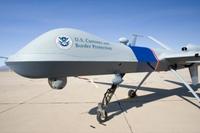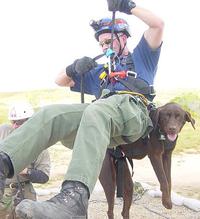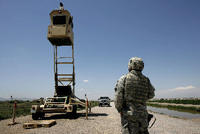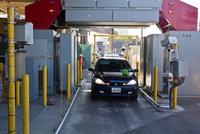-
House delays vote on “the toughest border security bill ever”
The House was supposed to vote on Wednsday on what Republicans have called “the toughest border security bill ever,” but the bill encountered harsh criticism from different sides of the GOP caucus. Some complained the measure does not address the pressing issue of immigration reform, while others complained it was the first step on slippery slope toward such reform. The border security bill, Secure Our Borders First Act (H.R. 399), sponsored by House Homeland Security Chairman Michael McCaul (R-Texas), would impose harsh penalties for federal agencies that fail to meet certain requirements. One mandate aims for DHS to achieve “operational control,” or prevent illegal entry across the southern border, within five years. If DHS fails to achieve that objective, political appointees at the agency would be prohibited from traveling in government vehicles, receive reimbursement for nonessential travel, or receive pay increases or bonuses.
-
-
Saudi Arabia constructing 600-mile wall along its border with Iraq
Saudi Arabia has been busy since September busy building a 600-mile East-to-West barrier which will run along its Northern border with Iraq.The primary purpose of the wall is to keep out Islamic State (ISIS) militants who have claimed that their goals are the eventual takeover of the holy cities of Mecca and Medinia, which lie well inside of Saudi Arabia’s borders.
-
-
DHS IG questions value of CBP’s border drone program
DHS’s 8-years-old drone program, now consisting of nine drones operating in Arizona, Texas, and North Dakota, has been unsuccessful, according to a just-released DHS inspector general report. Customs and Border Patrol(CBP) expected 23,000 total flight hours per year, but it only logged about 5,100 in fiscal year 2013. The inspector general’s report notes that drones helped in less than 2 percent of apprehensions of illegal immigrants.CBP has used the dronesto cover just 170 miles of the U.S. border – and a 2014 GAO report noted that a fifth of CBP drone flights were conducted within the interior of the United States and beyond the 100-mile range of operations of CBP jurisdiction points.
-
-
Drones watch over U.S. borders

Since 2000, the number of Border Patrol agents on the 1,954-mile U.S.-Mexico border has more than doubled, to surpass 18,000, and fencing has increased nine times — to 700 miles. Some members of Congress and border state lawmakers are calling for more border agents and more fencing, but the Obama administration is looking to drones to help reduce the number of illegal immigrants and drugs entering the United States, while simultaneously shifting resources and agents to parts of the border where illegal activity is highest.
-
-
Border Patrol canines are outfitted with wearable electronics

Wearable electronics are expected to generate more than $14 billion in 2014, and the market will reach $70 billion by 2024.Wearable devices have been integrated into the daily tasks performed by Border Patrol agents. Thousands of border agents are currently outfitted with smart wrist-watches, wearable cameras, and clothing equipped with health and safety sensors capable of monitoring body temperatures and stress levels.Border Patrol canines are outfitted with GPS-connected collars which allow border agents to keep track of their whereabouts.
-
-
New device sniffs out billions in U.S. currency smuggled across the border
Criminals are smuggling an estimated $30 billion in U.S. currency into Mexico each year from the United States, but help could be on the way for border guards, researchers reported. The answer to the problem: a portable device that identifies specific vapors given off by U.S. paper money.
-
-
Border surveillance towers deployment on hold as GAO seeks reevaluation

DHS’s plan to deploy fifty surveillance towers across southern Arizona is temporarily on hold, following a protest by Raytheonthat the agency improperly awarded the work to rival EFW. In a decisionreleased last Thursday by the Government Accountability Office(GAO), DHS has been asked to reevaluate the competitors’ proposals, saying that it is possible Raytheon was “prejudiced by the agency’s errors” during an evaluation of proposals.
-
-
No extra funding for increased Pentagon presence on southern border
Marine Corps Gen. John Kelly, commander of U.S. Southern Command (SOUTHCOM), has stated that illegal immigration and its effects are threatening to destabilize the region and are a national security threat to the United States. President Barack Obama’s $3.7 billion supplemental request to congress, however,, does not include any additional funding for military operations.
-
-
State collapse in the hemisphere an “existential” threat to U.S.: Southern Command chief
Marine Corps Gen. John Kelly, commander of U.S. Southern Command, is asking Congress to allocate more resources to help combat the flow of illegal drugs, weapons, and people from Central America. “In comparison to other global threats, the near collapse of societies in the hemisphere with the associated drug and (undocumented immigrant) flow are frequently viewed to be of low importance,” Kelly said. “Many argue these threats are not existential and do not challenge our national security. I disagree.”
-
-
Proposed border security surge threatens to create ghost towns along the border -- again

The U.S. Customs and Border Patrolhas apprehended more illegal immigrants in the Rio Grande Valley in the first eight months of fiscal 2014 (160,000) than it did for all of fiscal 2013 (154,453). Last May, agents apprehended over 1,100 illegal immigrants per day in the Rio Grande Valley. Texas officials have now authorized the Department of Public Safety(DPS) to send additional law enforcement personnel to patrol areas along the Texas-Mexico border at a cost of $1.3 million each week for the remainder of the year. Some residents compared the proposed surge, announced last week, to 2013’s Operation Strong Safety, which, these residents say, resembled a police state which created ghost towns along the border where illegal immigrants became afraid to go to work or send their children to school for fear of deportation.
-
-
2015 DHS budget is border patrol “wish list”: critics
Last week, the House Appropriations Committee approved $39.2 billion 2015 budget for the Department of Homeland Security (DHS). Critics were quick to point out that many items in the budget were not on the original budget request, but were since added after showing up originally on a wish list of hardware that could improve and extend the surveillance capabilities of DHS.
-
-
DHS revises rules for use of deadly force on border

On 30 May DHS released new guidelines detailing when the use of force by Border Patrol officials is authorized. The lack of explicit scenarios within the rules, however, has led to questions of when such acts are truly warranted.
-
-
New detection technology to help combat nuclear trafficking
According to the International Atomic Energy Agency (IAEA), the greatest danger to nuclear security comes from terrorists acquiring sufficient quantities of plutonium or highly enriched uranium (HEU) to construct a crude nuclear explosive device. The IAEA also notes that most cases of illicit nuclear trafficking have involved gram-level quantities, which can be challenging to detect with most inspection methods. Special algorithm coupled with commercial X-ray scanners allows detection of small amounts of fissile materials in luggage.
-
-
U.S.-Mexico border security barriers affect movement of animals
Security barriers in national parks on the U.S.-Mexican border which aim to deter illegal migrants are affecting the movements of some native animal species while not necessarily restricting the movement of humans, according to new research.
-
-
CBP takes another stab at high-tech border security

The George W. Bush administration’s effort to build a high-tech border security system – the Boeing-led SBINet – was a failure, and the Obama administration shut it down in 2011. CBP is now trying again, this time with Elbit Systems as the lead contractor. The hope is that the lessons of the doomed SBINet, and Elbit’s experience in building high-tech defensive systems along Israel’s borders, would yield better result this time around.
-
- All
- Regional
- Water
- Biometrics
- Borders/Immig
- Business
- Cybersecurity
- Detection
- Disasters
- Government
- Infrastructure
- International
- Public health
- Public Safety
- Communication interoperabillity
- Emergency services
- Emergency medical services
- Fire
- First response
- IEDs
- Law Enforcement
- Law Enforcement Technology
- Military technology
- Nonlethal weapons
- Nuclear weapons
- Personal protection equipment
- Police
- Notification /alert systems
- Situational awareness
- Weapons systems
- Sci-Tech
- Sector Reports
- Surveillance
- Transportation
Advertising & Marketing: advertise@newswirepubs.com
Editorial: editor@newswirepubs.com
General: info@newswirepubs.com
2010-2011 © News Wire Publications, LLC News Wire Publications, LLC
220 Old Country Road | Suite 200 | Mineola | New York | 11501
Permissions and Policies
Editorial: editor@newswirepubs.com
General: info@newswirepubs.com
2010-2011 © News Wire Publications, LLC News Wire Publications, LLC
220 Old Country Road | Suite 200 | Mineola | New York | 11501
Permissions and Policies
